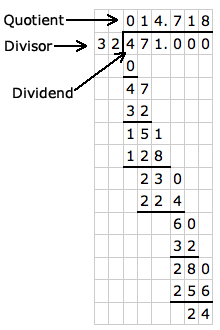1 50 As A Decimal
Long Partition Computer with Decimals
Reckoner Utilize
Do long sectionalization with decimal numbers and run into the piece of work for the calculation pace-by-step. Enter positive or negative decimal numbers for divisor and dividend and calculate a quotient respond.
How to Do Long Division with Decimals
- If the number yous're dividing by has a decimal, move the decimal bespeak all the style to the correct counting the number of places you've moved it to. So movement the decimal indicate in the number you're dividing the same number of places to the right.
- Insert a decimal point in the quotient (answer) space, exactly to a higher place the decimal point in the number under the division bar.
- Split until the residue is zero, or until you accept enough decimal places in your reply. You tin also end if the remainder repeats because this indicates that your answer is a repeating decimal.
Summate Decimal Places for a Quotient Respond
How far do you want to calculate the decimal places for the reply? Here are some examples:
- 31 divided by 16 = 1.937500 calculating to half dozen decimal places
- 31 divided by 16 = i.937 computing to 3 decimal places
- 22 divided by 15 = one.466666666 computing ix decimal places
- 22 divided by 15 = one.466666 calculating 6 decimal places
- 22 divided by 15 = 1.466 computing to 3 decimal places
Note that this is not the same equally rounding to a specific number of decimal places. For instance, 22 divided by 15 = 1.466 when calculated to 3 decimal places because you lot stop once you reach the third decimal place. On the other manus, 22 divided by fifteen = one.467 when rounded to 3 decimal places. In social club to circular to the third decimal place yous must calculate to at to the lowest degree the fourth decimal place and then that you know how to round the third decimal identify. See our Rounding Numbers Calculator for more data.
Also encounter our Long Sectionalisation with Remainders to see the work for long division with remainders.
Parts of Division
For the sectionalisation problem 471 divided by 32:
- 471 is the dividend
- 32 is the divisor
- 14.718 is the quotient calculated out to iii decimal places

How to practice Long Division with Decimals: Case
In this problem we divide 4.71 by three.2 out to 3 decimal places in the quotient answer.
Fix the problem with the long division subclass. Put the dividend inside the subclass and the divisor on the outside to the left.
If the divisor is a decimal number, move the decimal all the way to the right. Count the number of places and movement the decimal in the dividend the same number of places. Add zeroes if needed.
Since 3.2 is not a whole number move the decimal point one place to the right. 32 is a whole number. Do the same to the dividend and move the decimal one place to the right.
Since we are solving to three decimal places, add ii abaft zeroes to the dividend.
Insert a decimal point above the division bar, directly in a higher place the new decimal position in the dividend.
Separate the left about number of the dividend by the divisor, in this case divide 4 past 32.
Since 4 divided by 32 is non a whole number, the showtime caliber digit is 0.
Multiply the divisor 32 by the caliber 0 to get the production 0. Decrease 0 from four to become the residuum 4.
Next, bring downwards the 7 from the dividend then you lot have 47.
What is 47 divided by 32? Or in other words, how many times does 32 get into 47? Just once, with a remainder.
Insert 1 in the quotient. To find the remainder, multiply the divisor past 1 and subtract the production 32 from the 2d dividend 47. The residuum is fifteen.
Again, bring down the next digit from the dividend, 1, and place it at the end of the residual.
Repeat the steps. What is 151 divided past 32? Or, how many times does 32 go into 151?
32 goes into 151 four times. Put a 4 in the side by side place in the caliber and multiply 32 by four to become 128.
Subtract that product from 151 to detect a residuum of 23.
Bring down the 0 from the dividend and insert it afterward 23 to get 230.
What is 230 divided past 32? 32 goes into 230 seven times. Put a vii in the next identify in the quotient.
32 times 7 is 224.
230 minus 224 leaves a residual of 6.
Now bring down the side by side zip from the dividend and repeat the steps.
32 goes into 60 only in one case. Put a 1 in the side by side place in the quotient.
32 multiplied by 1 is 32.
Subtracting 32 from 60 leaves a remainder of 28.
Wikipedia: Long Segmentation
Follow CalculatorSoup:
![]()
![]()
1 50 As A Decimal,
Source: https://www.calculatorsoup.com/calculators/math/longdivisiondecimals.php
Posted by: rondonbetunink.blogspot.com


0 Response to "1 50 As A Decimal"
Post a Comment